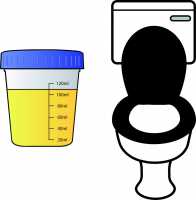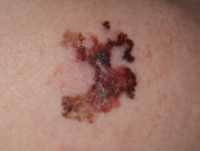MedicalResearch.com Interview with:
Chuan-Liang Xu, MD, PhD
Changhai Hospital of Shanghai
MedicalResearch.com: What is the background for this study? What are the main findings?
Response: Patients with urothelial carcinoma usually have to undergo lifelong cystoscopy for surveillance, because it recurred often. Cystoscopy is an examination which inserted a catheter with light and camera into the urethra and inspect the lining of the bladder. Cystoscopy is invasive and uncomfortable for the patients, and also cost a lot of money. Urothelial carcinoma is in direct contact with the urine, just like fish and water, and tumor cells might be flushed out by urine. Traditional method urine cytology is trying to find tumor cells in the urine by cytopathologist, but this method may miss up to 50 to 70% of tumor patient.
So, the main purpose of our study is to establish a new non-invasive, and more accurate method to detect urothelial cancer by analyzing the chromosomal alterations from the urine exfoliated cells, and reduce the use of cystoscopy. (more…)
Author Interviews, Biomarkers, Lymphoma / 14.08.2020
Melanoma: Florescent Biomarkers Detectable in Urine
MedicalResearch.com Interview with:
Dr. Ivana Špaková
Pavol Jozef Šafárik University
Košice, Slovakia
MedicalResearch.com: What is the background for this study?
Response: The background is the plenty of space for studying "waste metabolites" which tell us more about the metabolism of the whole body as well as about the metabolism of the smallest compartment - cell. So we decided to study what is the difference in urine spectra (absorbance, excitation, and emission spectra) in patients with malignant melanoma and healthy subjects without positive cancer history.
MedicalResearch.com: What are the main findings?
Response: The main findings are "discovery" (it is not true discovery because the target molecules or metabolites are known for decades) of molecules{metabolites which together describe the stage of malignant melanoma. These findings could be used for future tracking the patient's response for treatment or for tracking the previously treated patients for malignant melanoma and are healthy at the moment of sampling. (more…)
Author Interviews, Biomarkers, Cancer Research / 28.06.2020
Guardant Health’s LUNAR-2 Assay: A Big Step Toward Liquid Biopsy Diagnosis of Colon Cancer
MedicalResearch.com Interview with:
Dr. Kathryn Lang
VP, Outcomes and Evidence
Guardant Health
MedicalResearch.com: What is the background for this study?
Response: Despite a wide variety of screening methods available and increasing public awareness of the value of early detection, colorectal cancer (CRC) remains a leading cause of cancer-related deaths. However nearly 1 in 3 adults in the United States is not compliant with screening recommendations, with most citing that current screening methods are time consuming, unpleasant (stool-based testing), and in the case of colonoscopy, invasive. A blood-based CRC screening test could improve compliance rates by providing physicians with an opportunistic, in-office screening modality. However, demonstrating the clinical utility of blood-based cell-free circulating tumor DNA (ctDNA) fractions for the detection of cancer in asymptomatic individuals has thus far been challenged by the failure to achieve clinically meaningful sensitivity and specificity thresholds due to significantly lower tumor cell-free free DNA fractions and the increasing relevance of biological confounders.
The multi-modal approach of Guardant Health’s LUNAR-2 assay (genomics, methylation and fragmentomics) coupled with advanced bioinformatic analysis and a focused approach of honing in on the unique signals of CRC has been shown in previously reported cohorts to perform with sensitivity and specificity which satisfies the needs of clinicians in screening for CRC. (more…)
Author Interviews, Cancer Research, Genetic Research / 04.05.2020
Metastatic Breast Cancer: Tumor Profiling by Liquid Biopsy Can Help Drive Therapy
MedicalResearch.com Interview with:
Rebecca Nagy
Vice President Medical Affairs
Guardant Health
MedicalResearch.com: What is the background for this study?
Response: Hormone receptor positive (HR+) breast cancer comprises roughly 75% of all cancers of the breast. While many of these cancers can be cured through multi-modality therapy, there remain many deaths due to metastatic spread to distant organs. These metastatic cancers are marked by their resilience in the face of potent targeted therapies and chemotherapies, with many tumors displaying an initial drug response followed by resistance.
Recently, genomic sequencing has identified recurrent, oncogenic alterations in HR+ metastatic breast cancer (MBC) with mutations in the catalytic alpha subunit of PI3K (PI3Kα, PIK3CA gene), in over 40% of cases. This has raised hopes for more durable disease control through precise inhibition of this driver oncogene.
The SOLAR-1 Phase III study of alpelisib combined with fulvestrant in PIK3CA-mutated HR+ MBC showed a markedly improved PFS over fulvestrant monotherapy but pervasive resistance nonetheless. To characterize the basis for such resistance to combination hormone plus PIK3CA targeted therapy, we conducted a detailed, longitudinal analysis of tumor and plasma circulating cell-freetumor DNA (ctDNA) among patients with HR+ MBC who participated in a phase I/II dose escalation study of alpelisib in combination with letrozole or exemestane. (more…)
AACR, Author Interviews, Biomarkers, MD Anderson / 05.03.2019
Non-Small Cell Lung Cancer: Liquid Biopsy Pinpoints Treatment Options
MedicalResearch.com Interview with:
Vassiliki Papadimitrakopoulou, MD
Professor of Medicine
Department of Thoracic/Head and Neck Medical Oncology
MD Anderson Cancer Center in Houston
MedicalResearch.com: What is the background for this study? What are the main findings?
Response: 30% of patients with newly diagnosed advanced NSCLC can be treated successfully with targeted therapies, often yielding higher response rates than chemotherapy or immune checkpoint inhibitors. Selecting first-line therapy for patients with NSCLC requires assessment of an expanding list of guideline-recommended genomic biomarkers (EGFR, ALK, ROS1, BRAF, RET, MET amplification and exon 14 skipping, and ERBB2, with NTRK newly added)
Standard-of-care (SOC) testing relies on tissue, which is limited by biopsy-related risks, specimen insufficiency, and lab processing duration, which hamper timely optimal treatment selection
- NILE is a large, prospective, multicenter, head-to-head study of SOC tissue-based genomic testing to plasma-based comprehensive cfDNA genomic testing (Guardant360®). For the four biomarkers with FDA approved therapies, up to 34% of patients were tested by SOC tissue testing versus 95% with cfDNA testing. NILE met its primary endpoint - cfDNA performed similar to tissue in the detection of guideline-recommended biomarkers and cfDNA results were delivered significantly faster than SOC tissue testing (median 9 days vs. 15 days).Using cfDNA testing first, 87% of patients with a guideline-recommended biomarker would have been detected, compared to 67% if SOC tissue testing was first.
(more…)
Author Interviews, Biomarkers, Cancer Research, FASEB / 21.10.2018
TumorScan May Become a Universal Screening Blood Test For Cancer
MedicalResearch.com Interview with:
Prof. Diana Anderson
Established Chair in Biomedical Sciences
The University of Bradford Richmond Road Bradford West Yorkshire
MedicalResearch.com: What is the background for this study?
Response: I have worked in this field for over 40 years both as a research scientist in industry and as a university-based researcher. It has always been my ambition to develop a relatively simple and affordable test to predict if a person is sensitive to cancer. In fact, in 1974, I was appointed as Head of Mutagenesis Studies at ICI’s Central Toxicology Laboratory in Manchester, UK, and I was looking at developing a short-term test to predict cancer even back then.
Our ‘universal’ cancer test is different from other ‘universal’ tests being developed, because ours is not looking for a specific biomarker or mutation. Ours is a generic test for cancer in an individual, regardless of any underlying mechanism that’s causing their cancer.
It is known that levels of damage to the DNA in the cellular genome can correlate with cancer and this is what we set out to investigate with the Comet assay.
Of the available tests to detect damage to the genome the Comet assay is very straightforward. This assay was primarily developed as a method to measure DNA damage. Briefly, cells are embedded in agarose on a microscope slide and lysed to remove membranes leaving supercoiled DNA loops, breaks in which after alkaline treatment and alkaline electrophoresis move towards a positive charge. The DNA is stained with a fluorescent dye and visualised by fluorescent microscopy. The image is like Haley‘s comet and the greater number of breaks the greater is the migration to the anode and the greater the damage. (more…)
AACR, Author Interviews, Biomarkers, Colon Cancer / 05.09.2018
Serial Liquid Biopsies May Predict Response to Colon Cancer Treatment
MedicalResearch.com Interview with:
Dr. Andrea Sottoriva, PhD
Centre for Evolution and Cancer, The Institute of Cancer Research, London, United Kingdom
MedicalResearch.com: What is the background for this study? Would you briefly explain what is meant by a liquid biopsy?
Response: Cetuximab is a targeted treatment available for metastatic colorectal cancer patients. Unfortunately, although many patients benefit from Cetuximab, after an initial response to the treatment many patients relapse and become resistant to the drug.
We know that this resistance is due to the tumour evolving and adapting to therapy. Liquid biopsies allow to look for residual cancer DNA in the blood of a patient and hence monitor the emergence of resistance over time. We used blood samples take every 4 weeks (quite frequently for this type of study) to monitor the evolution of the cancers under treatment and see if there were some measurements that would predict if and when patients will relapse.
(more…)
Author Interviews, Biomarkers, Cancer Research, Journal Clinical Oncology, Lymphoma, Stanford / 23.08.2018
Liquid Biopsy Using Circulating Tumor DNA Can Predict Treatment Response in Large B-Cell Lymphoma
MedicalResearch.com Interview with:
Dr. David Kurtz, MD/PhD, Instructor and
Dr. Ash Alizadeh MD/PhD, Associate Professor
Division of Oncology, Department of Medicine
Stanford University Medical Center
MedicalResearch.com: What is the background for this study? What are the main findings?
Response: This work investigates the utility of circulating tumor DNA - a type of liquid biopsy - in diffuse large B-cell lymphoma, the most common blood cancer in adults.
Liquid biopsies are an emerging technology to track cancers from a simple blood draw. Here, using a cohort of over 200 patients from 6 centers across North America and Europe, we asked if circulating tumor DNA could be used to detect lymphoma in patients, and more importantly, could it be used to identify responders and non-responders. (more…)
Author Interviews, Cancer Research, JAMA, Prostate Cancer / 26.07.2018
Liquid Biopsy for CTCs Can Predict Treatment Response in Advanced Prostate Cancer
MedicalResearch.com Interview with:
Alison L. Allan, PhD
Department of Oncology, Western University
London Regional Cancer Program, London Health Sciences Centre
London, Ontario, Canada
MedicalResearch.com: What is the background for this study? What are the main findings?
Response: This was an international collaborative study between Lawson Health Research Institute (London, ON), Memorial Sloan Kettering Cancer Center (New York), the Royal Marsden (London, UK) and molecular diagnostics company Epic Sciences (San Diego, CA). The study used a liquid biopsy test developed by Epic Sciences that examines circulating tumour cells (CTCs) in blood samples from patients with advanced prostate cancer who are deciding whether to switch from hormone-targeting therapy to chemotherapy. CTCs are cancer cells that leave a tumour, enter the blood stream and invade other parts of the body, causing the spread of cancer. The test identifies whether or not a patient’s CTCs contain a protein in the nucleus called AR-V7. The research team set out to determine whether the presence of this protein predicted which treatment would best prolong a patient’s life.
They found that patients who tested positive for the protein responded best to taxane-based chemotherapy while those who tested negative for the protein responded best to hormone-targeting therapy with drugs called androgen-receptor signaling (ARS) inhibitors. These are the two most widely used drug classes to treat advanced prostate cancer.
(more…)
Author Interviews, Biomarkers, Breast Cancer, JAMA, Radiation Therapy / 03.05.2018
Liquid Biopsy Can Guide Radiation Therapy in Early Stage Breast Cancer
MedicalResearch.com Interview with:
Chelain Goodman, MD PhD
PGY-3, Radiation Oncology
Northwestern University
Chicago, IL 60611
MedicalResearch.com: What is the background for this study?
Response: Circulating tumor cells are cancer cells that are shed from the primary tumor into the peripheral blood stream and are hypothesized to be one of the first steps in the initiation of metastatic progression. Prospective studies have demonstrated that approximately 15-25% of patients with early-stage breast cancer can be found to have at least one circulating tumor cell in a small sample of their blood. Currently, all patients with early-stage invasive breast cancer who undergo breast conserving surgery receive adjuvant radiation therapy. In these analyses, we wanted to determine whether presence of circulating tumor cells may be predictive of benefit of radiation therapy following surgery.
(more…)
ASCO, Author Interviews, Biomarkers, Cancer Research, Gastrointestinal Disease / 02.02.2018
Liquid Biopsy Results for Cancer Mutations May Differ – Study Compares Idylla platform vs to OncoBEAM RAS CRC assay
MedicalResearch.com Interview with:
Dr. Ana Vivancos PhD, Principal Investigator
Cancer Genomics Group
Vall d'Hebron Institute of Oncology (VHIO
Barcelona
MedicalResearch.com: What is the background for this study? What are the main findings?
Response: Our study was designed to address a key issue in liquid biopsy testing: analytical sensitivity. We know that mutations in plasma of mCRC patients show a wide range in their allelic frequencies (0.01-90%), the biological basis for which remains unclear. We also know that around 35% of cases show very low mutant allele fractions (MAFs), < 1%, therefore highlighting the need of using high sensitivity techniques in the routine lab in order to properly detect mutations.
We have compared two different testing methods that are being used in liquid biopsy:
Digital PCR (OncoBEAM RAS test, BEAMing) with a limit of detection of 0.02% vs qPCR (Idylla ctKRAS test, Biocartis) with an analytical sensitivity of 1%.
Our findings indicate that detection sensitivity decreases for the qPCR based method in cases with low MAF (<1%) and more so when MAF values are very low (<0.01%).
(more…)
Author Interviews, Cancer Research, JAMA, Johns Hopkins / 16.12.2017
Liquid Biopsies Sent To Different Labs May Yield Different Results
MedicalResearch.com Interview with:
Gonzalo Torga, MD
Urology Department
Johns Hopkins Hospital
Baltimore, MD 21287
MedicalResearch.com: What is the background for this study? What are the main findings?
Response: Liquid biopsy is a new and noninvasive alternative to tumor tissue sequencing, and it is intended to specifically detect and sequence tumor DNA circulating in patients’ blood. The results are used to help guide oncologists to tailor the best treatment for patients at each point of their disease. Our research was initially aimed at finding the best commercial lab to test samples from metastatic prostate cancer patients. We wanted to make the best choice for our patients, so we started submitting the samples to both places at the same time to compare results. However, we found significant disparities in the results from identical patient samples submitted to two different commercial liquid biopsy providers, and we believed it would be important to share them with the oncology community.
The two liquid biopsy panels compared were the Guardant360, from Guardant Health, Inc., which sequenced at least part of the coding sequences of 73 genes; and the PlasmaSELECT panel from Personal Genome Diagnostics, which sequenced coding segments of 64 genes. Both laboratories were licensed by Clinical Laboratory Improvement Amendments (CLIA) and accredited by the College of American Pathologists (CAP), and report having high sensitivity (in this case, the ability to correctly identify mutations when they occur) and high specificity (the ability to correctly report as negative when those mutations are not present). The two companies differ in which genes, and regions within each gene, are covered. Just 25 of the 40 patients in the study had at least one genetic mutation reported within the overlapping genetic sequences covered by both companies.
Even when the companies were analyzing DNA from the same blood drawn, their results rarely matched each other. When comparing results within the overlapping genetic sequences, the results from both companies completely matched for all the mutations reported in only 7.5 percent (3 of 40 patients) of cases. In 15 percent of the patients (6 of 40), both companies’ results matched for at least one of the reported mutations. In 40 percent (16 of 40) of the patients, no mutations reported that were potentially covered by both panels were detected by both companies.
(more…)
Author Interviews, Biomarkers, Lung Cancer, Personalized Medicine, University of Pennsylvania / 13.09.2016
Penn Reports Successful Pilot Study of Liquid Biopsy To Monitor Advanced Lung Cancer
MedicalResearch.com Interview with:
Erica L. Carpenter, MBA, PhD
Research Assistant Professor, Department of Medicine
Director, Circulating Tumor Material Laboratory
Division of Hematology/Oncology
Abramson Cancer Center
Perelman School of Medicine at the University of Pennsylvania
MedicalResearch.com: What is the background for this study? What are the main findings?
Response: The advent of precision medicine practices for cancer patients, including the use of drugs that target specific tumor mutations, has necessitated improved diagnostics with real-time molecular monitoring of patients' tumor burden. While biopsy material, obtained surgically or through fine needle aspirate, can provide tissue for next generation sequencing (NGS) and mutation detection, this requires an invasive often painful procedure for the patient. In many cases, especially in more advanced disease when multiple metastases are present, such tissue cannot be obtained or can only be obtained from a single tumor site, thus limiting the sensitivity of tissue-based biopsy.
Here we report on a prospective cohort of 102 consecutively enrolled patients with advanced non-small lung cancer (NSCLC) for whom a non-invasive liquid biopsy was used for real-time detection of therapeutically targetable mutations. Tissue samples were only obtainable for 50 of the 102 patients, and these tissue biopsies were analyzed using a 47-gene Next Generation Sequencing (NGS) panel at Penn's Center for Personalized Diagnostics. Concordance of results for the 50 patients who received both tests was close to 100% when the samples were obtained concurrently.
(more…)
AACR, Author Interviews, Biomarkers, Cancer Research, Colon Cancer, Technology / 27.04.2016
New Technology Can Detect Circulating Colon Cancer Cells In Less Than an Hour
MedicalResearch.com Interview with:
Dr. Elodie Sollier PhD
Chief Scientific Officer at Vortex Biosciences
MedicalResearch.com: What is the background for this study? What are the main findings?
Response: Vortex Biosciences has developed a fast and simple way to isolate and collect intact circulating tumor cells (CTCs) directly from whole blood in less than an hour using a process based on microfluidics. To better understand the utility of the technology for the clinical setting, PCR-based Sanger sequencing was used to profile the mutations of CTCs isolated from blood from metastatic Colorectal cancer patients. The mutations were compared to primary tumor biopsies, secondary tumor biopsies and ctDNA. There are 3 primary take-aways:
- The Vortex technology captures CTCs with enough purity to perform sensitive and accurate PCR-based Sanger sequencing.
- Mutations present in primary and secondary tumors can be identified in both CTCs and ctDNA making liquid biopsies a valuable alternative to tissue biopsies.
- While there is general consistency of mutations identified, some mutations are only identified in CTCs while others only in ctDNA demonstrating how these are indeed complimentary.









